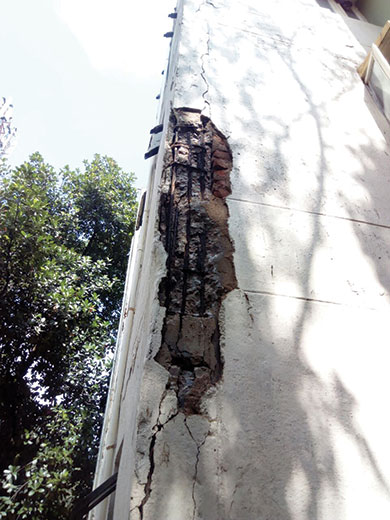Remedial measures for reinforced concrete structures using cementitious materials
M. N. Ramesh, Director, Talrak Construction Chemicals Pvt. Ltd., Bangalore
 An essential part of a successful repair of concrete structures, is to establish the underlying cause and extent of concrete deficiency, and deterioration mechanism. For a repair to be successfully completed, it must eliminate the cause, repair the full extent of the damage, and ensure that the structure is protected from further damage or recurrence of the original cause for the whole of its projected lifespan.
An essential part of a successful repair of concrete structures, is to establish the underlying cause and extent of concrete deficiency, and deterioration mechanism. For a repair to be successfully completed, it must eliminate the cause, repair the full extent of the damage, and ensure that the structure is protected from further damage or recurrence of the original cause for the whole of its projected lifespan.
It is therefore important that a thorough initial investigation should be carried out before any repair work is undertaken. It must be emphasised that failure to carry out a detailed investigation/assessment can lead to an incorrect diagnosis of the problem with subsequent unsuitable and ineffective methods of repair. In many cases, visual observations should be supplemented with other supporting data, based on diagnostic assessment to determine the mechanism that caused the problem.
A key issue that needs to be highlighted in any repair, is the importance of maintaining the structural integrity of structures. Work should be done safely and excessive material should not be removed, particularly from load bearing members. Consideration should be given to whether the concrete to be removed provides essential support for the structure. A structural check or professional structural advice should be considered, and, where ever necessary, propping and temporary supports should be provided.
Methods of application of repair materials are mainly dictated by the prevailing in-service conditions, relative costs, the specified performance characteristics of suitable repair materials, as well as the level of in-service performance required from such materials. Other factors which contribute to the selection of a particular method of application include horizontal, vertical or overhead repair conditions; restricted access; ease and practicality of erection of formwork; structural limitations; underwater requirements; prevailing traffic conditions and; tidal and splash zone repairs.
Introduction

It is therefore important that a thorough initial investigation should be carried out before any repair work is undertaken. It must be emphasised that failure to carry out a detailed investigation/assessment can lead to an incorrect diagnosis of the problem with subsequent unsuitable and ineffective methods of repair. In many cases, visual observations should be supplemented with other supporting data, based on diagnostic assessment to determine the mechanism that caused the problem.
A key issue that needs to be highlighted in any repair, is the importance of maintaining the structural integrity of structures. Work should be done safely and excessive material should not be removed, particularly from load bearing members. Consideration should be given to whether the concrete to be removed provides essential support for the structure. A structural check or professional structural advice should be considered, and, where ever necessary, propping and temporary supports should be provided.
Methods of repair and application
For the purposes of repair of concrete structures, repairs can be grouped into two general categories, namely the ones associated with corrosion deteriorated concrete, and the ones associated with non-corrosion deteriorated concrete (i.e. accidental damage which does not incorporate the corrosion process). The major difference in the repair process is associated with the initial stages of the repair, where some aspects of the total exposure and de-rusting of steel reinforcement may not be relevant to non-corrosion deteriorated concrete (i.e. accidental damage) repair (1, 3). In addition, the initial stage of removal of concrete and overall surface preparation is generally relevant to all methods of application. For obvious reasons, the remaining repair stages are different, which reflects the difference of the various methods of application and the materials associated with these methods.Methods of application of repair materials are mainly dictated by the prevailing in-service conditions, relative costs, the specified performance characteristics of suitable repair materials, as well as the level of in-service performance required from such materials. Other factors which contribute to the selection of a particular method of application include horizontal, vertical or overhead repair conditions; restricted access; ease and practicality of erection of formwork; structural limitations; underwater requirements; prevailing traffic conditions and; tidal and splash zone repairs.
This is a premium article available exclusively for our subscribers.
If you are already a subscriber, please Login
If not, subscribe now and get access to well researched articles & reports on infrastructure construction, equipment & machinery, innovations & technology, project reports, case studies, and more. All this by simply paying just ₹200/- for a month of complete portal access, or a discounted rate of ₹1000/- for a full year of access.
NBM&CW February 2017



















